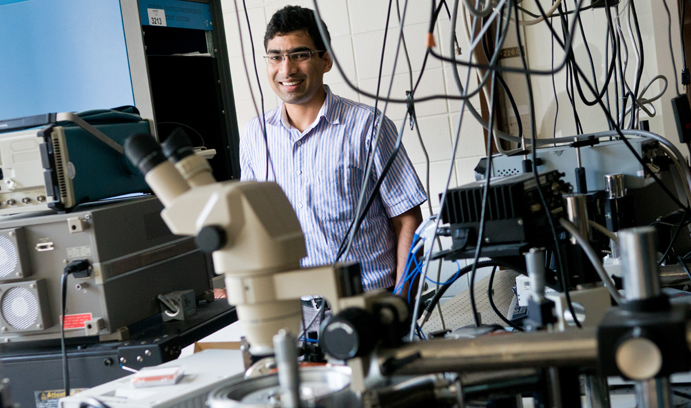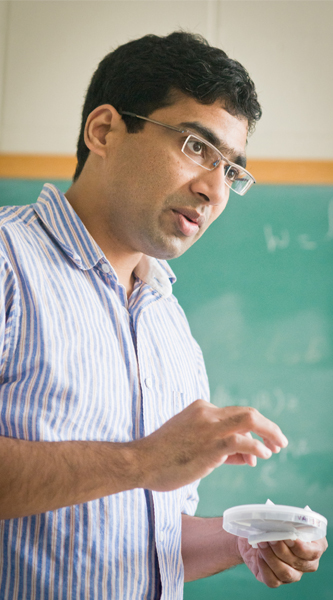A Superlattice to Generate the Elusive Terahertz Wave

To make progress toward operating terahertz lasers at room temperature, professor Sushil Kumar has turned to nanoscale technology.Working with researchers at Sandia National Laboratories, he is developing laser designs that involve assembly of a semiconductor superlattice of more than 1,500 alternating semiconductor layers of precise thickness and arrangement.
From radio waves, which are used for wireless communications and found at low frequencies, to gamma ray detection of cosmic rays at the highest frequencies, we take advantage of nearly the entire electromagnetic spectrum today.
Yet one region of the spectrum, sandwiched between microwave and infrared frequencies, is hardly utilized. Known as terahertz (THz) radiation, the portion of the EM spectrum between 1012 and 1013 Hz promises advances in areas as diverse as atmospheric science, astronomy, cancer research, drug detection, DNA sensing, cell biology and nondestructive testing of pharmaceuticals.
The reason for the “terahertz gap,” says Sushil Kumar, is that scientists have not developed reliable and convenient sources of generating high-power and coherent THz radiation.
Kumar, assistant professor of electrical and computer engineering, hopes to close this gap by developing a semiconductor laser that can generate THz waves at room temperature.
Semiconductor lasers for mid-infrared frequencies, known as quantum-cascade lasers (QCL), were developed two decades ago, work at room temperature and are used commercially.THz QCLs work with similar operating principles. But they need to be cryogenically cooled to function, and this rules out portability, low cost and easy use in labs and offices.
A miniature laser source for THz radiation that runs at or near room temperature and is low cost and high power, says Kumar, would lead to rapid commercialization of THz technology.
“My goal is to be able to do with THz what we can do with mid-infrared radiation now,” says Kumar, who recently received an NSF CAREER Award. In Kumar’s lab, several elegant but heavy instruments sit by tanks of liquid nitrogen, which are necessary for the cooling process to operate the QCLs.
Recently, smaller cooling devices known as Stirling cryocoolers, he says, have enabled his group to achieve QCL functionality at temperatures above 150 K (about minus 123 degrees Celsius) for a range of lasers emitting at different THz frequencies.
To make progress toward operating THz lasers at room temperature, Kumar has turned to nanoscale technology. Working with researchers at Sandia National Laboratories, he is developing laser designs that involve assembly of a semiconductor superlattice of more than 1,500 alternating semiconductor layers of precise thickness and arrangement. When an electric current is applied, electrons travel within the sandwich-like structure, generating coherent light. Kumar and his colleagues were the first to exploit thermal vibrations in the semiconductor lattice as means of injecting electrons for laser operation in THz QCLs, changing the way electrons cascade in the superlattice and achieving robust optical gain even at relatively high temperatures.
Recently, Kumar’s group has significantly improved its laser’s beam quality by making the device emit radiation similar to the way a microwave antenna does.
A THz laser emission scatters and loses intensity quickly over a short distance, because its wavelength is larger than the dimensions of the laser device itself. Kumar’s group has overcome this problem by altering the design of the periodic pattern of “distributed feedback grating” at the top of the laser cavity. The result is a much narrower beam spot than what was possible earlier, he says.
“We have early indications that our idea may be able to produce THz QCLs with some of the best beam profiles of any THz QCLs reported,” he says.
Kumar stumbled into his field by chance. Prior to doing his Ph.D. at MIT, his training had included neither photonics nor quantum mechanics. But he was invited to work with a professor whose group was the only one in the U.S. conducting research into THz QCLs. Peering into the THz gap, he says, was like catching a glimpse of a lesser-explored region of space.
Kumar envisions handheld THz devices that can sniff out hidden explosives or chemical weapons from a safe distance, or larger devices that can collect new information from space to help us understand the formation of planets, stars and galaxies.
He is among a relatively small community of scientists working with THz waves.
“It’s a very active research area,” he says, “with many questions still to be answered.”
Posted on:


